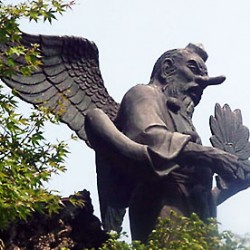Tengu 天狗 are mountain and forest goblins with both Shinto and Buddhist attributes. Their supernatural powers include shape-shifting into human or animal forms, the ability to speak to humans without moving their mouth, the magic of moving instantly from place to place without using their wings, and the sorcery to appear uninvited in the dreams of the living.
The patron of martial arts, the bird-like Tengu is a skilled warrior and mischief maker, especially prone to playing tricks on arrogant and vainglorious Buddhist priests, and to punishing those who willfully misuse knowledge and authority to gain fame or position. In bygone days, they also inflicted their punishments on vain and arrogant samurai warriors. They dislike braggarts, and those who corrupt the Dharma (Buddhist Law).
The literal meaning of Tengu is "Heaven 天” and “Dog 狗." In Chinese mythology, there is a related creature named Tien Kou (Tiangou 天狗), or "celestial hound." The name is misleading, however, as the crow-like Tengu looks nothing like a dog. One plausible theory is that the Chinese Tien Kou derived its name from a destructive meteor that hit China sometime in the 6th century BC. The tail of the falling body resembled that of a dog, hence the name and its initial association with destructive powers.
Historical Notes. Tengu mythology was probably introduced to Japan in the 6th or 7th century AD, in conjunction with the arrival of Buddhism from Korea and China. These goblins thereafter appear in Japan’s ancient documents (e.g., from around 720 AD), and are closely associated with Mount Kurama in Japan (near Kibune), the abode of the legendary white-haired Sōjōbō (Sojobo) 僧正坊, King of Tengu. In Myths and Legends of Japan (1913; by F. Hadland Davis), the Tengu are said to emanate from the primordial Japanese god Susano-o. Tengu lore can be found not just in Buddhist circles, but also among Shinto, Budo, and Ninpo groups. As late as 1860, the Edo Government was posting official notices to the Tengu, asking the goblins to temporarily vacate a certain mountain during a scheduled visit by the Shogun (see Japan and China, by Captain Brinkley). see de Visser’s report
10th Kyu – Mukyu 無 級
9th Kyu – Kyukyu 九 級
8th Kyu – Hachikyu 八 級
7th Kyu – Nanakyu 七 級
6th Kyu – Rokukyu 六 級
5th Kyu – Gokyu 五 級
4th Kyu – Yonkyu 四 級
3rd Kyu – Sankyu 参 級
2nd Kyu – Nikyu 弐 級
1st Kyu – Ikkyu 級
1st Dan – Shodan 初 段
2nd Dan – Nidan 弐 段
3rd Dan – Sandan 参 段
4th Dan – Yondan 四 段
5th Dan – Godan 五 段
6th Dan – Rokudan 六 段
7th Dan – Nanadan 七 段
8th Dan – Hachidan 八 段
9th Dan – Kyudan 九 段
10th Dan – Judan 十 段
11th Dan – Jushodan 拾 初 段
12th Dan – Junidan 拾 弐 段
13th Dan – Jusandan 拾 参 段
14th Dan – Juyondan 拾 四 段
15th Dan – Jugodan 拾 五 段
Shidoshi-Ho 士 道 師 補
Shidoshi 士 道 師
Shihan 師 範
Soke 宗 家